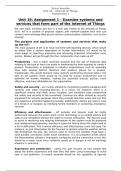Victor Anosike
Unit 19 – Internet of Things
Assignment 1
Unit 19: Assignment 1 – Examine systems and
services that form part of the Internet of Things
We now work, socialise and live in a new way thanks to the Internet of Things
(IoT). IoT is a system of physical objects and network-capable tech that can
connect and exchange data across various communication networks, such as the
internet.
The purpose and application of systems and services that make
up the IoT:
The main purpose of IoT is to have real-time self-reporting devices, which would
be better than a system dependent on human intervention. IoT would be far
more adept at searching analysing and retrieving important information more
quickly. Below I will go through the four components that make up IoT:
Productivity – this is when real-time analysis and the use of historical data
relating to the task at hand can assist in shortening the time required to create a
product. Productivity is employed in industry organisations such as assembly
lines with several distinct divisions that produce pieces for a product.
Traditionally, this would demand many workers performing physical labour, but
with an IoT system, there would be no need for human involvement and no
potential for human mistakes, making the assembly process quicker, more
effective, and more affordable for the organisation.
Safety and security – are mostly utilised for monitoring systems equipped with
cameras and video recording devices. In a home, for instance, there is a
significant chance that theft, arson, burglary, and vandalism may compromise
the safety and security of the household. Cameras are often utilised as security
equipment for security purposes since they provide real-time vision and can film
any suspicious activities happening outside, additionally, alarms are used in case
of a break-in or burglary by notifying family members or contacting emergency
services
Efficiency and effectiveness – IoT systems and devices must be highly
performant because the entire point of the technology is to enable actions and
tasks to be completed without the need for human interaction. The devices used
to assist in retrieving and relaying information to the system must be produced
and configured appropriately, leaving no space for failure since this might lead to
a lot of difficulties. This is where efficiency and effectiveness come into play. For
instance, to give information for the forecast to declare what the weather will be
like throughout the day, the sensors used to record the weather must have a
solid durable connection under harsh conditions. If a circumstance arises where
the thermometer utilised is improperly configured and the connection is lost, this
would be a major issue since residents would be in danger if not for warnings
ahead or in real-time.
Experience and satisfaction – Lastly, this part focuses on how people feel
about the entire experience and how they feel after using technology to solve
new or old problems. A current example would be the capability to operate
, Victor Anosike
Unit 19 – Internet of Things
Assignment 1
thermostats and boilers remotely; consumers would find this to be a highly
efficient method to regulate the temperature in their homes when they are home
and away. This eliminates the inconvenience of having to stop what they're
doing and go adjust it. If they have already left their house, they can now turn it
off without having to go back.
The purpose and application of IoT systems and services
from different sectors
IoT is incorporated into our daily life whether we realise it or not. The bulk of the
computerised or electronic items we use every day are thought to have or use an
IoT system. However, the way and why an IoT system is used divides it into
distinct areas. There are four sectors in total: home, well-being, industrial
and transportation, and retail and commerce.
Energy monitoring and control systems are more likely
to be found in homes. Because it is a location of
comfort and privacy, it is much easier to install and
operate technologies such as smart metres and
cameras as the household sees fit. Home entertainment
systems include motion-tracking gaming controllers and
mobile devices.
The health and well-being sector would be
used the most by hospitals and health-related
organisations. Wearable or implantable devices
would be used to help promote good health or to
measure and monitor the activities occurring
within the human body.
In the industrial and transportation sector,
machine control and automatic recognition
technologies would be used. The
manufacturing industry would gain from
improved machine performance via machine-
controlled systems, increasing productivity
and efficiency, while road tolling would profit
from improved equipment for recording
passing number plates using radio frequency identification (RFID).
Retail and commerce would include a lot of
tracking, tracing, advertising, and customer
participation. To satisfy users, companies must
have rapid delivery times with clear
notifications and updates of customers' goods,
which is where order tracking comes in handy if a
consumer wants to know where their shipment is.




